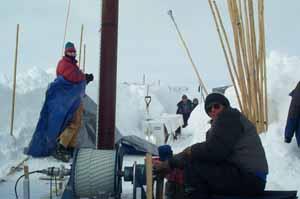18 May, 2003
Weather:
Very warm – above 0 degrees F, light snow but very little wind!!!! We could even see the horizon and a few breaks in the clouds.
Camplife:
We set our alarms so we could be drilling by 5:30am. If everything was going smoothly at 9am we were going to call Kangerlussuaq and have the Otter pilots pick us up at the end of the day. We have a lot of gear so they were going to do some shuttling of ice core boxes and then pick us up on their way back. We will have 25 boxes, each holding 6 1meter cores. Each box will weigh about 100 pounds.
Science: ICE TALKS
As I have explained before as new layers of snow accumulate on top of the existing layers of snow and ice the old ice is covered up. The deeper we drill the older the ice is. As it snows, gases can be locked in the snow. One interesting and confusing part is that the gas can move freely through the snow and ice for many years. What this means is that the age of the ice is different than the age of the gas that is caught in the ice.
When it snows, the snow is fluffy and has many pores that gases can move through. Over many years more snow is accumulated on top of the old snow putting more pressure on it and finally closing the pores so gases cannot move through it. Picture little tunnels in the snow and after awhile the pressure on top of the tunnels squeezes them closed. Once this happens the gases that are in the ice are locked inside. For example, the gases in the atmosphere right now could possibly move 50m below the surface and become locked in the ice that is 100’s of years old. That is why there is a difference between the age of the ice and the age of the gases that are locked into the ice. Ice cores are the only way to study gases from the past at this time. For scientists this is very important as they make their models for understanding climates and change.
The deeper the ice is, the more pressure is put on the gases in the ice. The fun part for non-scientists is to put this ice into a warm liquid such as soda or water and listen to the ice. The gases that are in the ice want to be relieved of the pressure and make popping sounds as they are released from the ice. This ice is notably called ‘party’ ice because it is fun to use!! One problem with this ice is that it can be very fragile. Because of the gas pressure in the ice, the ice can ‘explode’ in situations if it is bumped. If you are picturing an explosion like a bomb you are a little strong, however the ice can shatter into many pieces. We are not drilling deep enough to get ice that has that much pressure but in deep drilling operations, say below 400m, this could happen.
Unfortunately we cannot bring any ice home as it will be studied, however if little pieces have broken off we can put those in warm water and hear them talk!
Even deeper in the ice, the ice takes on a different look. The gases are so pressurized that they are forced into the matrix of the molecules of ice. This makes the ice very clear and very strong as compared to above were the pressure could actually cause the ice to fracture into pieces.

Contact the TEA in the field at
.
If you cannot connect through your browser, copy the
TEA's e-mail address in the "To:" line of
your favorite e-mail package.
|
